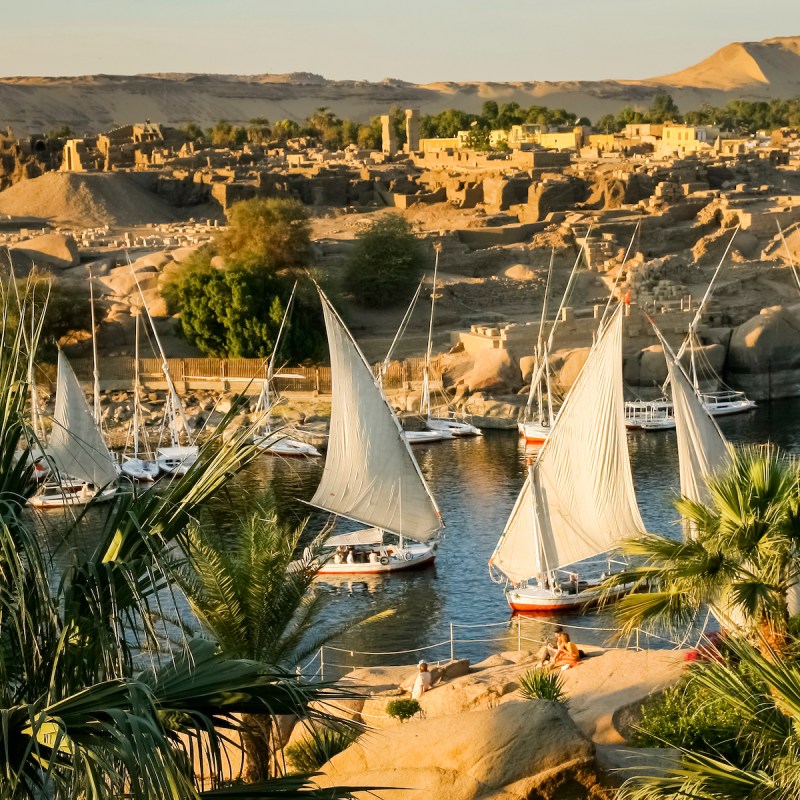
When Viking launched its first purpose-built Nile River cruise ship in August 2022, voyages through the heart of Egypt immediately became more accessible, luxurious, and exciting.
Videos by TravelAwaits
Viking also offers Viking Aton, which debuted in August 2023, so even more cruisers have a chance to take a voyage in style in this exotic destination.
Viking Osiris and Viking Aton both carry up to 82 passengers on five spacious decks and the ships are outfitted with roomy staterooms, lounges, restaurants, bright public areas, and a beautiful open sun deck.
While these comfortable ships certainly set the standard for Nile River cruising, that’s only part of what makes a Viking river cruise in Egypt such a wonderful experience. We sailed on one of the first voyages on Viking Osiris and found a host of great activities that travelers will love.

1. The Great Pyramid
Viking’s Nile River cruise program starts with three nights at a luxury hotel in Cairo. You begin your immersive journey in Egypt’s capital, where you have a comfortable place to eat and relax — and even enjoy the pool, spa, restaurants, and fitness center — after your long flight to Egypt.
While here, you meet your Viking Egyptologists, who will take you to one of the top highlights of your trip, the Great Pyramid Complex of Giza. This is the world-renowned attraction of three massive pyramids, including the Great Pyramid of Khufu.
These three structures, built more than 4,500 years ago, make an amazing spectacle in the hot desert. The symmetry and size offer a testament to the architectural mastery of ancient Egyptians who built these fantastic tombs for the pharaohs. You can even venture inside the Great Pyramid, creeping along a tight and hot passageway to the King’s Chamber.
Pro Tip: Our guide for the journey on Viking Osiris warned us that there would be a lot of high-pressure hawkers selling trinkets and souvenir items at the Great Pyramid Complex (as well as at several sites and temples during our voyage). Her best tip was that we simply do not engage with them in any way if we were not interested in buying anything at that time.

2. The Great Sphinx On Camelback
Viking covers the fee for a short camel ride and photo opportunity during your visit to the Great Pyramid site. It’s thrilling to nestle atop of one of these fascinating animals and feel it lift you high above the Sahara to saunter along the sand for about 15 minutes. Your guides will happily snap an iconic photo of you astride your camel with the stunning pyramids in the background.
Adjacent to the pyramids is the Great Sphinx. Your day in Giza continues with a visit to this famed attraction, too.
Pro Tip: Be ready with your camera or cell phone to hand it over to your camel guide so that he can take a few pictures for you during your ride.

3. Valley Of The Kings
The Viking Osiris Nile River cruise itinerary visits Luxor for some of the most-anticipated days of adventure. Viking offers a premium shore excursion that is that rare one-of-a-kind experience.
The early-morning balloon ride over the Valley of the Kings (and the Valley of the Queens) allows you to see the sun rise and illuminate the vast mountain range and valley that was the final resting place for Egypt’s great pharaohs, including Rameses II and King Tut.
Cruisers rise around 3:30 a.m. and head across the river to the West Bank to watch the balloons inflate and take shape before they rise majestically into the sky. Seeing the colorful balloons floating all around while you ride in your basket with a group of new friends as the golden sun emerges on the horizon makes for a jaw-dropping spectacle.
Pro Tip: Dress in layers for this activity and bring a water bottle. It’s cool in the morning before the sun rises in the desert, but it quickly heats up throughout your ride. You can peel off layers as needed.

4. King Tut’s Famous Burial Site
While in Luxor, you also will be able to visit King Tut’s tomb in the Valley of the Kings. Viking takes cruisers over for a full tour of the impressive burial sites, with the tombs carved deep inside the mountains.
You wander down long passages to visit chambers, with every wall ornately decorated with colorful murals. The art depicted the daily life and religious doctrine of ancient Egyptians.
King Tutankhamun’s mummy is on display within the tomb, and you can also visit the crypts of some of the most notable pharaohs of ancient Egypt. These include Ramses I, Ramses III, Seti II and Merenptah.

5. The Grand Temples Of Karnak And Luxor
These two historic sites are nearby, and cruisers get to visit them both during Viking’s time in Luxor.
The Luxor and Karnak Temple complexes are filled with a mix of well-preserved and decaying chapels, massive pylons and columns, and other structures on which construction began more than 4,000 years ago. These sprawling sites are filled with carvings, statues, and engravings that depict stories and cultural aspects of society at the time.
Karnak Temple is one of the largest in the world and the second-most visited tourist site in Egypt, ranking behind the Great Pyramid Complex.
Pro Tip: Hats, scarves, water, and good walking shoes are essential for visiting these sites and all temple sites in Egypt.

6. Abu Simbel And Other Incredible Temples
While the temples of Karnak and Luxor are notorious as two of Egypt’s most famous temples, cruisers on a Viking Nile River voyage will get to see many other spectacular temple sites along the journey.
In Quena, a town right on the river, you’ll be amazed by the blue colors of the murals and art on the walls of the well-preserved Dendera Temple of Hathor. At Esna, you can explore the temple dedicated to the water god Khnum, who was worshiped as the guardian of the Nile’s headwaters.
Edfu is fun to visit, especially because you can enjoy a ride to the Temple of Horus on a traditional horse-drawn caliche.
When in Aswan, though, I highly recommend Viking’s premium excursion (added fee) that takes cruisers to Abu Simbel. The Temples of Abu Simbel are a marvel for their beauty and scale. Plus, the story of the rediscovery and a massive relocation project to preserve them is fascinating.
Abu Simbel was built in the 13th century and honors Ramses II. Lost to the sands of time, it was uncovered in the early 19th century. This UNESCO World Heritage site was moved in 1968 to accommodate the construction of the Aswan Dam that controls the flow of the vital Nile River.
Abu Simbel was moved more than 200 feet higher and 650 feet farther inland.
It sits in its new place with a striking facade of four enormous statues of Ramses II guarding the entrance of the sandstone temples.

7. The Nile River
The best thing about traveling right through the heart of Egypt on your Nile River cruise is that you get to see the landscape and scenery from a different perspective. As you sail from port to port, you also will be happy to call a luxury river boat such as Viking Osiris your home.
The top Sun Deck offers plenty of comfy seating areas to take in the green banks of the river that are framed by the brown mountains in the distance. You also will be enticed to enjoy a sunset cocktail in the aft infinity pool as you cruise the exotic and historic waterway. We were charmed by the young children seen playing and swimming along the Nile’s banks, waving excitedly to greet us as we sailed past.

8. The Egyptian Museum
In Cairo, Viking includes a tour of the Egyptian Museum of Antiquities. This is where you can see tens of thousands of pieces from the times of the ancient pharaohs. These include magnificent sarcophaguses, statues, tools, jewelry, murals, writings, and the famed golden mask of King Tut.

9. Bustling Markets
Cairo, Giza, Luxor, Aswan, and Esna all offer opportunities to visit small and large souks (marketplaces), where you can shop for souvenirs, regional foods, spices, or other items of interest. Here, you’ll get to engage with very friendly people who rely heavily on tourist dollars for income.
Pro Tip: Don’t agree on the first price offered. Egyptians love to negotiate, and they welcome the chance to haggle a bit before you both agree to a fair price.

10. Aswan Dam
Viking spends two days in Aswan, and this is a chance to learn about the High Dam project and how it was built in the 1960s to provide stability to the fertile lands along the Nile. Before the dam, the region had problems with flood conditions ruining crops and leading to famine. The High Dam created the 300-mile-long Lake Nasser, which now offers irrigation and electricity. Cruisers can tour the dam and later ride a traditional wooden felucca boat on the Nile River.
